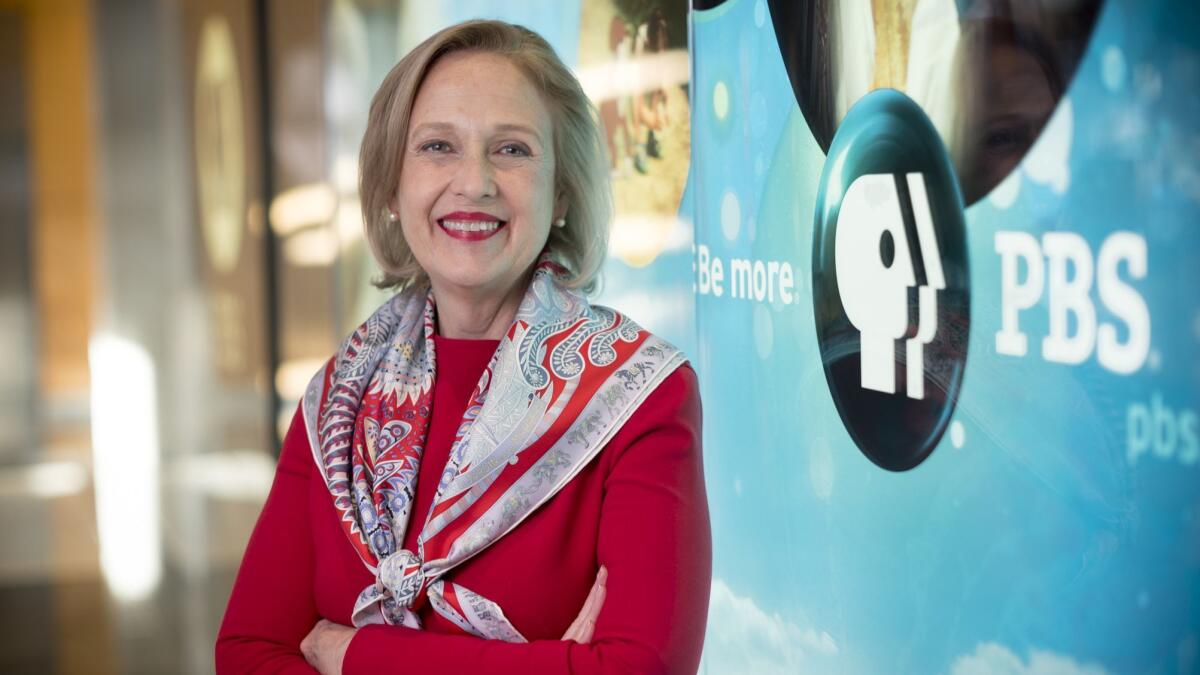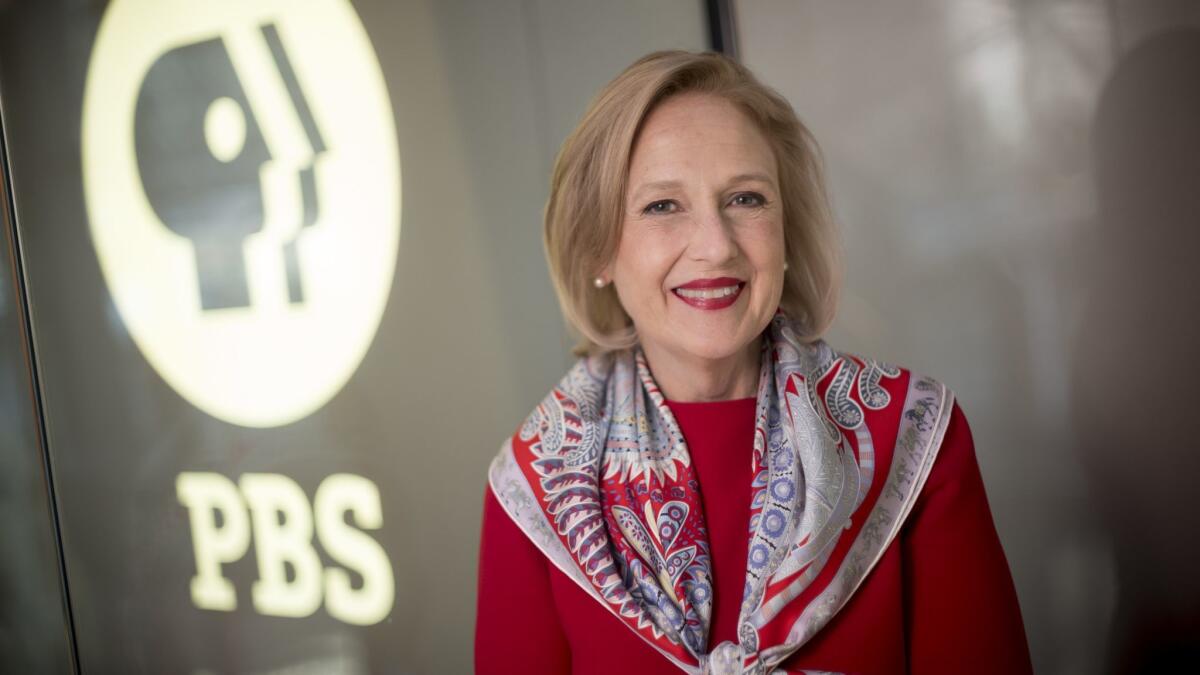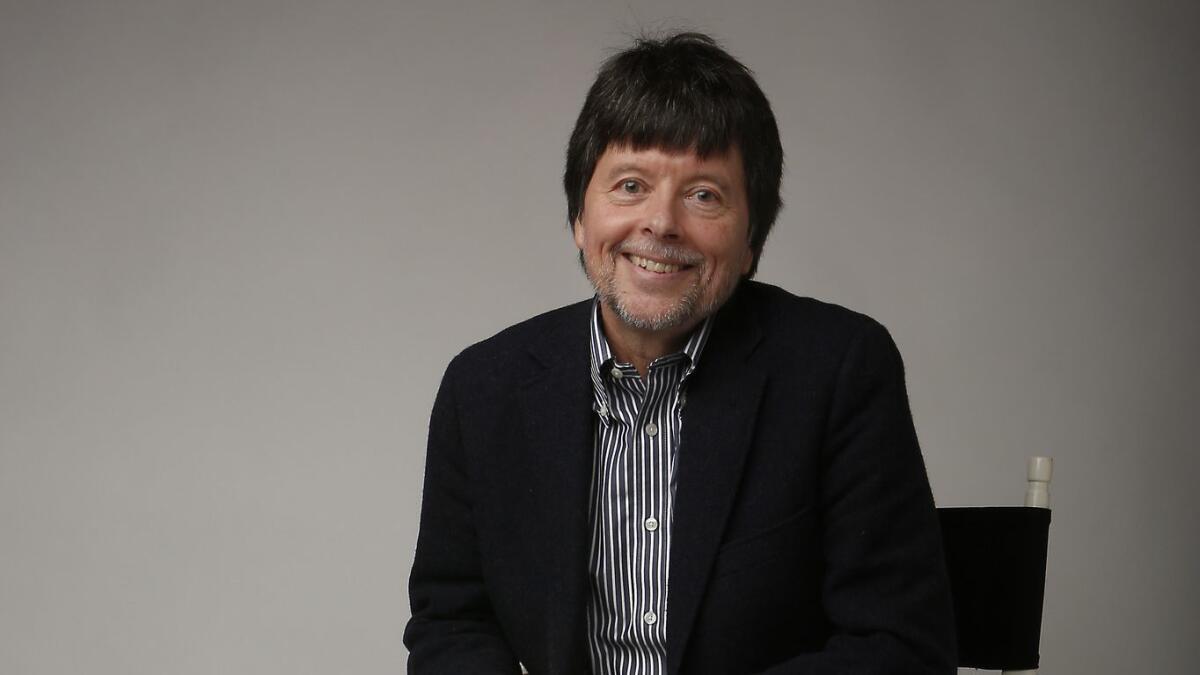The Conversation: PBS President Paula Kerger on replacing Charlie Rose, keeping Ken Burns and streaming

- Share via
Reporting from Crystal City, Va. — Paula Kerger has visited 49 states since she took over as president and chief executive of PBS in 2006. And after all those miles and new studio ribbon cuttings, it’s the words of a farmer who drove five hours to see her during a visit in Lincoln, Neb., that stands out most in her mind. The traveler told her that PBS was vital to him while growing up in rural America and that he expected it to be there for his children as well.
“He wanted me to remember his face and wanted to tell me not to mess it up,” Kerger recalls during a recent chat in her office in Crystal City, Va.
So far, so good. Kerger has the longest tenure of anyone who has held the top PBS job. As ratings for broadcast and cable TV have declined over the years due to increased competition from streaming, the relative popularity of PBS has actually improved. It ranks as the the sixth-most watched TV network after falling to 12th a decade ago, according to Nielsen. Even with the myriad of choices viewers have today, 230 million people watch their local PBS TV stations each year.
Kerger, 61, has guided public television’s move into digital streaming. Along with tote bags and mugs, contributing members can now get a subscription to PBS Passport, a streaming video on demand service that gives access to the newest episode of “Victoria” before it airs Sunday nights. Kerger has also navigated through a #MeToo crisis that led to her replacing PBS late-night talk hosts Charlie Rose and Tavis Smiley with a new program featuring CNN senior international correspondent Christiane Amanpour.
In this interview, she talks about all of that plus why PBS and the viewing needs of that Nebraska farmer still matter in the age of Peak TV.

Viewing of PBS has really stabilized during your tenure. Is it a halo effect from having a hit on the scale of “Downton Abby” for many of those years?
Some of it. We’ve tried to stay pretty close to what we think is our guide star — programming that is entertaining and interesting but also of substance. When others who were exactly in this space, like History Channel, began to do more reality-type programming, we stayed the course.
What are the signature programs for PBS right now?
We have a very big audience for “Masterpiece” on Sunday nights. The most important thing we do on a week-to-week basis is “Frontline.” I don’t see a lot of people in that space at all. Investigative journalism, as you know, is expensive. And I would say, from a brand perspective, Ken Burns’ documentary work. His next piece is an 16-hour deep dive into country music this summer, which is really fantastic.

There is a lot of deep-pocketed competition from streaming companies out there. Is your worst nightmare Netflix pursuing Ken Burns with an unlimited amount of funding?
Others have tried to throw a lot of money at him, and he’s here for a reason. He’s on the road all year for country music because he believes through our stations his work could be really important. Netflix would get him out of the fundraising business where he does not want to spend his time. But his program would not have the impact it has on public television.
Are you looking at doing exclusive programming for PBS Passport?
We’ve been working with our stations to acquire some things that maybe you can’t watch on television but can get on Passport so it becomes a way of really thanking people who are helping their station. But obviously, we want to be very careful that we’re providing a robust [broadcast] service that’s free for everyone. I look at Passport similarly to when we sell DVDs.
You’ve also launched a 24-hour PBS Kids network that can be streamed online or watched over the air with an antenna.
There is a focus of public broadcasting that is also about access. A lot of kids, particularly in over-the-air homes, don’t have a lot of opportunity for high-quality educational content at night and weekends when most kids are watching. We have done exactly what we had set out to do, which is providing content for low-income kids.
In 2015, the producers of “Sesame Street” sold the first run of the children’s program to HBO, which now airs episodes before PBS. How has that arrangement worked out?
They’re really helping principally to fund a series that has been tremendously important for kids, which I think is great. I wish we didn’t have the delay, because the HBO audience sees it nine months before the PBS audience. But I have to say, HBO has been a good partner in this. “Sesame Street” had a new Muppet character who is autistic, and there was a lot of promotion around that. And HBO did not hold those back — they were broadcast on PBS at the same time. I was anxious about it when the deal was struck. I continue to watch it carefully.
You had to replace an iconic PBS program after the Washington Post revealed sexual harassment allegations against Charlie Rose in 2017. What kind of viewer response did you get after taking him off the air?
It was particularly painful for me because I started at [New York public station] WNET when we took the show national. People still say to me, “I still miss Charlie,” or “Can’t you bring him back?”
What do you tell them?
“No, I’m not going to bring him back. I like the show we have on the air right now and I think we broadened the show into something that works better for our audiences and for public television.”
Are you surprised when people ask for his return?
I am. And we talk about it, and usually at the end they say, “Yeah, you’re right. You probably can’t bring him back.”
The replacement program, “Amanpour & Company,” actually has a younger and more diverse audience in the time period. How important was it to get a female host to replace Rose?
What we set out to do was to find someone who brought the right quality of conversation. The fact that she is a woman made it an even better choice. I’m particularly happy to have Christiane in the role, because I think she’s the best.
Los Angeles TV station KCET left PBS in 2010, just before “Downton Abbey” became a hit. Last year, it rejoined the network and merged with Orange County’s KOCE. What does the change mean for viewers?
I’m really very happy that they’re back. We have missed having a producing presence in Southern California. And that’s what I’m really hoping we’ll develop. With a large creative community, we should have work coming out of L.A.
Fred Rogers is having an impressive revival between the documentary “Won’t You Be My Neighbor?” and an upcoming feature about his life where he’s played by Tom Hanks. Short of bringing Mr. Rogers back as a hologram, is there a way to build on this in some way?
We are doing some additional work with his production company. When we did “Daniel Tiger’s Neighborhood” [a PBS Kids series based on a “Mister Rogers’ Neighborhood” segment], there was a lot of discussion about how the show was constructed, because you can’t bring Fred back. But I think what you can do is pay tribute to that legacy.
Why is he touching a nerve right now?
I think as people struggle to feel of value here is someone who looked right into the camera and told you he liked you the way you are and that everyone has value. That really resonates.
Twitter: @SteveBattaglio
More to Read
Inside the business of entertainment
The Wide Shot brings you news, analysis and insights on everything from streaming wars to production — and what it all means for the future.
You may occasionally receive promotional content from the Los Angeles Times.











